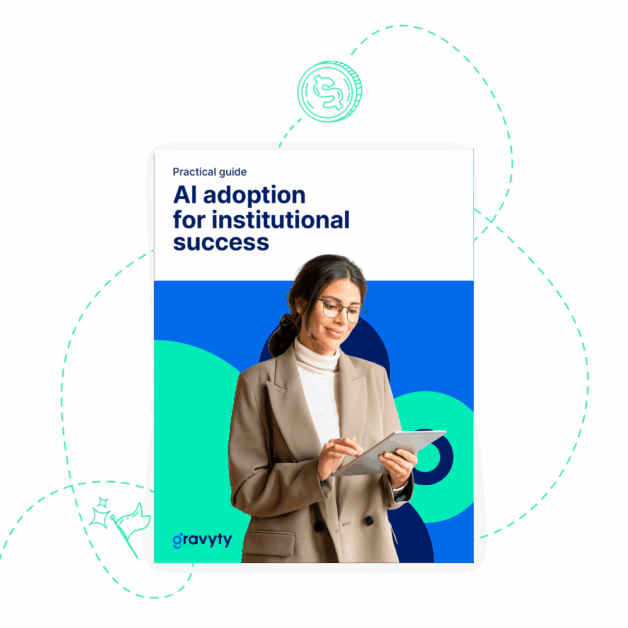What is a hybrid chatbot? A deep dive into the best type of chatbot for higher education

Students today expect quick, convenient, and personalized answers—whether it’s about their class schedule, financial aid, or housing. And most administrative teams at colleges and universities can’t keep up with the sheer volume of questions students ask across multiple channels.
That’s where chatbots for higher education come in. When implemented strategically, a chatbot can provide 24/7 support, guide students through important steps, and free up staff from repetitive tasks. But with so many chatbot options available, how do you know which one is best for your institution?
In this guide, we’ll break down the four types of chatbots you’ll encounter, their pros and cons, and which type of chatbot is widely considered the best choice for higher education.
What is a higher education chatbot?
A chatbot for higher education is a digital assistant that uses automation and often AI to communicate with students through natural language. Chatbots can be deployed on a university website, inside a student portal, through a mobile app, and even over SMS.
Instead of waiting days for an email reply or calling during office hours, students can type in a question—like “When is the FAFSA due?” or “Where do I find tutoring services?”—and get an instant response.
For schools, chatbots reduce strain on staff by handling repetitive FAQs, while ensuring students feel supported throughout their entire academic journey, from application to graduation.
The 4 types of chatbots for colleges & universities
Not every chatbot is created equal! Here are the four main types of chatbots used in higher education today, along with their strengths and weaknesses.
1. Rule-based chatbots
Rule-based chatbots follow a decision tree. They don’t use AI to guide interactions. Instead, they rely on pre-programmed questions and answers to guide students down a narrow path. While popular in business—roughly 60% of B2B and B2C companies leverage rule-based chatbots to answer customer queries—they don’t offer the hyper-personalized, sophisticated experience AI-powered bots provide for serving students.
Pros:
- Simple to build and launch: Schools can create basic scripts quickly without technical expertise.
- Reliable for FAQs: Works well when questions are predictable and phrased exactly as expected.
Cons:
- Limited scope: Can’t handle complex or nuanced questions beyond the rules it’s given.
- Rigid and inflexible: If a student phrases a question differently, the bot often fails to understand.
- Poor user experience: Students may feel like they’re just clicking through menus instead of having a real conversation.
Download the AI Adoption Guide
Today’s students expect instant answers, personalized support and a seamless experience. But admin teams are facing burnout and shrinking budgets. With the right AI tools, your team can break down silos and scale support.
In this guide:
- Real-world use cases across departments
- Tips for building buy-in and overcome blockers
- Roadmap to a scalable AI program
2. Keyword recognition chatbots
Keyword chatbots are similar to rule-based bots, but they return results solely based on combinations of customizable keywords. Keyword recognition bots scan a student’s question for specific words or phrases, then serve up an answer tied to those terms.
Some chatbots feature a hybrid menu and keyword approach, but neither “learns” on an ongoing basis.
Pros:
- More adaptable than rule-based bots: They can recognize a wider variety of phrasing as long as key terms are included.
- Good for mid-level complexity: A helpful step up for institutions that want more flexibility without going full AI.
Cons:
- Context challenges: A keyword like “aid” might confuse the bot (financial aid vs. medical aid).
- Still limited conversationally: Responses often feel generic, and misunderstandings are common.
- Requires careful keyword mapping: Staff must anticipate every term a student might use.
3. AI-powered chatbots
AI-powered chatbots use natural language processing (NLP) and machine learning to interpret questions and respond conversationally. Over time, they improve as they learn from interactions. Students are familiar with AI-powered bots due to exposure with ChatGPT and other large language model chatbots — over a third of students regularly use ChatGPT in education today.
Pros:
- More human-like: Students feel like they’re chatting with a real person.
- Broad coverage: Can handle a wide range of questions, even those not worded in expected ways.
- Continuous learning: The more conversations it has, the better it gets.
Cons:
- Training data required: Performance depends on how well the AI has been trained with relevant student data.
- Complex issues still need humans: AI can answer most questions but isn’t suited for sensitive or unique cases like appeals or emergencies.
4. Hybrid chatbots (AI + human support)
Hybrid chatbots combine the speed and scalability of AI with the personal touch of human staff. This makes them the best chatbot for higher education today. It’s table-stakes today for colleges and universities to provide students round-the-clock support (A recent Salesforce report found 63% of students wish they had access to 24/7 assistance). At the same time, some student inquiries require a human touch, like a mental health concern. Hybrid chatbots bridge these gaps to provide a holistic approach to student support.
Here’s how they work:
- AI answers routine questions instantly—covering 80–90% of student inquiries.
- Escalation happens seamlessly for more complex issues, connecting the student with a live staff member.
- Staff and AI work together to provide efficient, personalized, and always-available support.
Pros:
- 24/7 student availability: No matter when a student reaches out, they’ll get help right away.
- Balanced approach: Routine tasks are automated, while humans focus on higher-level cases.
- Better student satisfaction: Students feel supported without the frustration of “robotic” dead-ends.
- Scalability: Handles thousands of inquiries without overwhelming staff.
Cons:
- More sophisticated to set up: Requires thoughtful integration with systems like SIS and CRM. However, many solutions make it easy to plug into existing systems to start integrating immediately for powerful, holistic student experiences.
- Investment needed: Works best when schools commit resources to both AI training and human workflows.
Why hybrid chatbots are the best choice for colleges & universities
Higher education communication is complex. A financial aid office, for example, might receive hundreds of similar questions about FAFSA, award timelines, and disbursement. An AI chatbot can handle those instantly—but when a student asks about an unusual situation, human staff need to step in.
That’s why hybrid chatbots are the clear winner. They provide:
- Improved outcomes: Schools using hybrid bots report better enrollment yield, retention rates, and student satisfaction.
- Instant support at scale: Students don’t wait for answers, and staff avoid email overload.
- Personalized experiences: Escalation to staff ensures empathy and nuance when needed.
This is the approach we at Gravyty take with Ivy & Ocelot, our hybrid AI student engagement platform. Ivy & Ocelot brings together AI efficiency and human connection to support each student in the most optimal way.
Chatbots vs. other student communication channels
While email, phone calls, and portals still have their place, they often fall short when immediacy and escalation matter.

Chatbots don’t replace tried-and-true communication channels, but rather, they enhance your school’s student outreach strategy by offering immediate, round-the-clock support as a supplement to mass communications.
FAQs about chatbots for higher education
Q: What is the best chatbot for higher education?
A: In our opinion, the best type of chatbot for higher education is a hybrid chatbot, like Ivy & Ocelot from Gravyty. Hybrid bots combine instant AI-powered answers with seamless staff escalation, ensuring students always feel supported while staff avoid repetitive workload.
Q: How do chatbots improve student communication?
A: Chatbots make it easier for schools to connect with students by providing 24/7 availability, reducing wait times, and answering thousands of questions simultaneously. Instead of sending multiple emails or waiting on hold, students get the information they need immediately.
Q: Are higher education chatbots secure?
A: While no two chatbot vendors are exactly alike, leading chatbot providers for colleges and universities like Gravyty follow strict compliance standards like FERPA and GDPR to protect student data and privacy. This ensures conversations are safe, confidential, and trustworthy.
Q: Can chatbots integrate with existing university systems?
A: Absolutely. Many modern chatbots like Ivy & Ocelot are designed to work seamlessly with SIS, CRM, and LMS platforms. This allows schools to deliver more personalized responses—like pulling up a student’s class schedule or financial aid status—without manual intervention.
Q: Do students actually like the chatbots?
A: Surveys show that students overwhelmingly prefer quick, mobile-first communication. When done well, chatbots feel natural and helpful, especially when combined with the option to connect with a live staff member when needed. A recent report from EducationDynamics found that 90% of students who have utilized their school’s chatbots found them helpful.
The future of chatbots in higher education
The student journey is becoming increasingly digital. From admissions to alumni engagement, students expect real-time, mobile-first communication that feels personal and supportive.
Chatbots are becoming essential infrastructure for modern universities. And hybrid chatbots, in particular, strike the right balance between efficiency and empathy.
With Ivy & Ocelot from Gravyty, schools can deliver on these expectations while easing the burden on staff. The outcome: more engaged students, more efficient staff, and stronger institutional outcomes. Want to see it for yourself? Take our self-guided product tour below.




